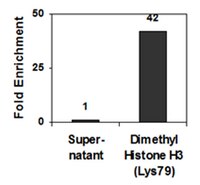04-835-S Sigma-AldrichAnti-dimethyl-Histone H3 (Lys79) Antibody, clone NL59, Trial Size, rabbit monoclonal
Anti-dimethyl-Histone H3 (Lys79) Antibody, clone NL59 is a rabbit monoclonal antibody for detection of dimethyl-Histone H3 (Lys79) also known as H3K79me2, Histone H3 (di methyl K79) & has been validated in ChIP, WB, DB, Mplex.
More>> Anti-dimethyl-Histone H3 (Lys79) Antibody, clone NL59 is a rabbit monoclonal antibody for detection of dimethyl-Histone H3 (Lys79) also known as H3K79me2, Histone H3 (di methyl K79) & has been validated in ChIP, WB, DB, Mplex. Less<<Recommended Products
Áttekintés
| Replacement Information |
|---|
Kulcsspecifikációk táblázata
| Species Reactivity | Key Applications | Host | Format | Antibody Type |
|---|---|---|---|---|
| H, Vrt | WB, DB, Mplex, ChIP-seq, ChIP | Rb | Culture Supernatant | Monoclonal Antibody |
| References |
|---|
| Product Information | |
|---|---|
| Format | Culture Supernatant |
| Presentation | Culture supernantant in 0.05% sodium azide |
| Quality Level | MQ100 |
| Physicochemical Information |
|---|
| Dimensions |
|---|
| Materials Information |
|---|
| Toxicological Information |
|---|
| Safety Information according to GHS |
|---|
| Safety Information |
|---|
| Storage and Shipping Information | |
|---|---|
| Storage Conditions | Stable for 1 year at -20°C from date of receipt. Avoid repeated freeze/thaw cycles, which may damage IgG and affect product performance. |
| Packaging Information | |
|---|---|
| Material Size | 10 µL |
| Transport Information |
|---|
| Supplemental Information |
|---|
| Specifications |
|---|
| Global Trade Item Number | |
|---|---|
| Katalógusszám | GTIN |
| 04-835-S | 04053252929878 |
Documentation
Anti-dimethyl-Histone H3 (Lys79) Antibody, clone NL59, Trial Size, rabbit monoclonal MSDS
| Title |
|---|














